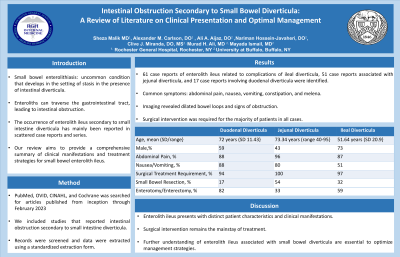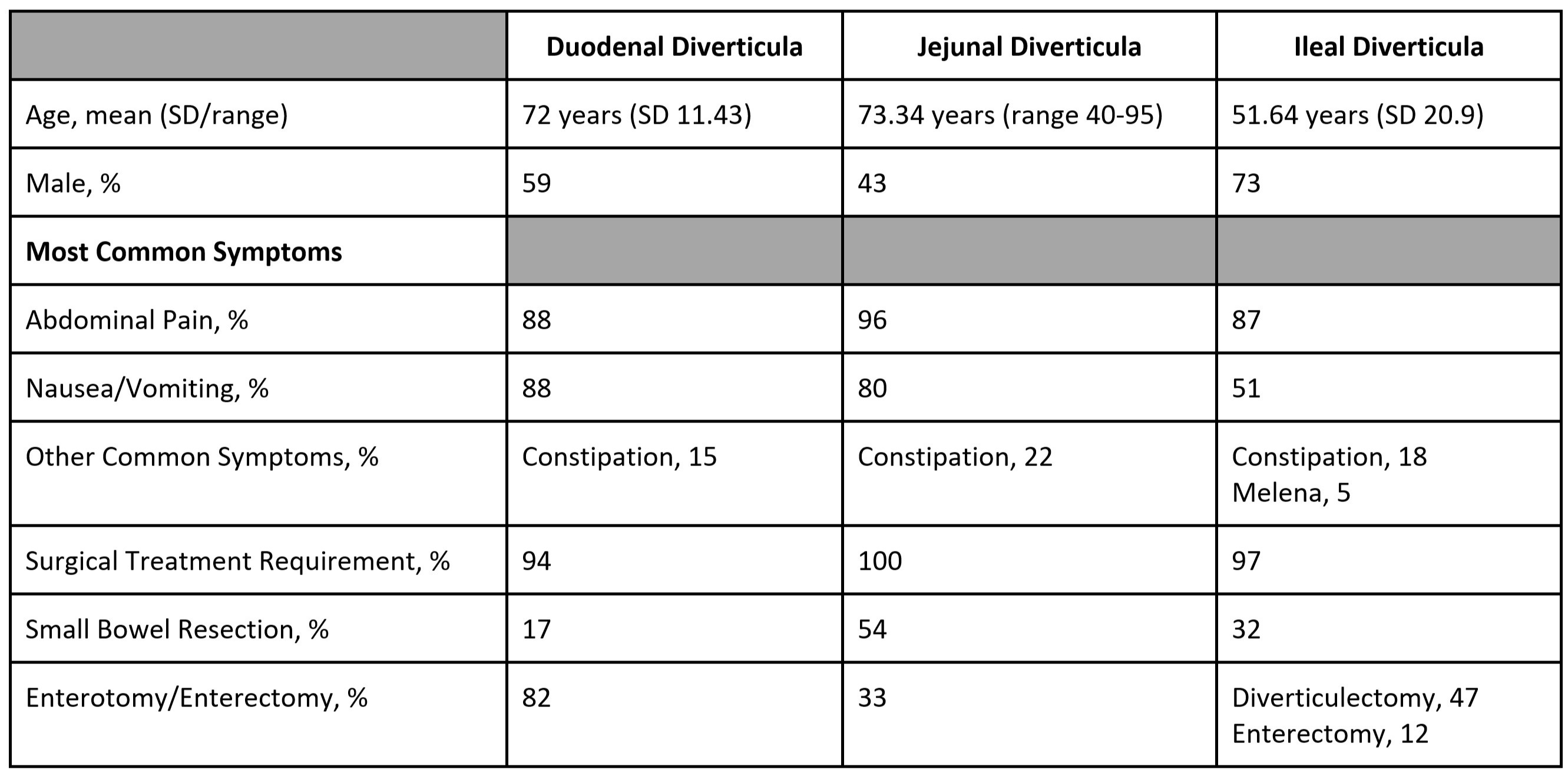Tuesday Poster Session
Category: Small Intestine
P4113 - Intestinal Obstruction Secondary to Small Bowel Diverticula: A Review of Literature on Clinical Presentation and Optimal Management
Tuesday, October 24, 2023
10:30 AM - 4:00 PM PT
Location: Exhibit Hall

Has Audio
- SM
Sheza Malik, MD
Rochester General Hospital
Rochester, NY
Presenting Author(s)
Sheza Malik, MD1, Alexander M. Carlson, DO2, Ali A.. Aijaz, DO2, Nariman Hossein-Javaheri, DO2, Clive J. Miranda, DO, MS2, Murad H. Ali, MD2, Mayada Ismail, MD2
1Rochester General Hospital, Rochester, NY; 2University at Buffalo, Buffalo, NY
Introduction: Small bowel enterolithiasis is an uncommon condition that develops in the setting of stasis in the presence of intestinal diverticula. Enteroliths can traverse the gastrointestinal tract, leading to various forms of intestinal obstruction, ranging from acute to chronic, and partial to complete, and can significantly increase morbidity. The occurrence of enterolith ileus secondary to small intestine diverticula has mainly been reported in scattered case reports and case series. Our review aims to provide a comprehensive summary of clinical manifestations and treatment strategies for small bowel enterolith ileus.
Methods: A comprehensive search of four databases (PubMed, OVID, CINAHL, and Cochrane) was conducted for articles published from inception through February 2023, without language or geographical restrictions. We included studies that reported intestinal obstruction secondary to small intestine diverticula. Records were screened and data were extracted using a standardized extraction form
Results: Literature search identified 326 studies matching initial criteria. Subsequent filtering narrowed our final study tally to 61 case reports of enterolith ileus related to complications of ileal diverticula, 51 case reports associated with jejunal diverticula, and 17 case reports involving duodenal diverticula. The average patient ages were 51.64 years, 73.34 years, and 72 years, respectively, with varying gender distributions. Common symptoms included abdominal pain, nausea, vomiting, constipation, and melena. Physical examination findings often showed localized abdominal tenderness. Diagnostic tests via x-ray and computed tomography consistently revealed dilated bowel loops and signs of obstruction. Surgical intervention was required for the majority of patients in all three cases, with diverticulectomy, enterectomy, and bowel resection being the most frequently performed procedures, yielding high success rates. Table 1 summarizes our findings.
Discussion: In conclusion, enterolith ileus secondary to complications of different diverticula presents with distinct patient characteristics and clinical manifestations. Conservative medical management has yielded some success, but surgical intervention remains the mainstay of treatment for most cases, with highly favorable postoperative outcomes. Further research and understanding of enterolith ileus associated with small bowel diverticula are essential to optimize management strategies and improve patient outcomes.

Disclosures:
Sheza Malik, MD1, Alexander M. Carlson, DO2, Ali A.. Aijaz, DO2, Nariman Hossein-Javaheri, DO2, Clive J. Miranda, DO, MS2, Murad H. Ali, MD2, Mayada Ismail, MD2. P4113 - Intestinal Obstruction Secondary to Small Bowel Diverticula: A Review of Literature on Clinical Presentation and Optimal Management, ACG 2023 Annual Scientific Meeting Abstracts. Vancouver, BC, Canada: American College of Gastroenterology.
1Rochester General Hospital, Rochester, NY; 2University at Buffalo, Buffalo, NY
Introduction: Small bowel enterolithiasis is an uncommon condition that develops in the setting of stasis in the presence of intestinal diverticula. Enteroliths can traverse the gastrointestinal tract, leading to various forms of intestinal obstruction, ranging from acute to chronic, and partial to complete, and can significantly increase morbidity. The occurrence of enterolith ileus secondary to small intestine diverticula has mainly been reported in scattered case reports and case series. Our review aims to provide a comprehensive summary of clinical manifestations and treatment strategies for small bowel enterolith ileus.
Methods: A comprehensive search of four databases (PubMed, OVID, CINAHL, and Cochrane) was conducted for articles published from inception through February 2023, without language or geographical restrictions. We included studies that reported intestinal obstruction secondary to small intestine diverticula. Records were screened and data were extracted using a standardized extraction form
Results: Literature search identified 326 studies matching initial criteria. Subsequent filtering narrowed our final study tally to 61 case reports of enterolith ileus related to complications of ileal diverticula, 51 case reports associated with jejunal diverticula, and 17 case reports involving duodenal diverticula. The average patient ages were 51.64 years, 73.34 years, and 72 years, respectively, with varying gender distributions. Common symptoms included abdominal pain, nausea, vomiting, constipation, and melena. Physical examination findings often showed localized abdominal tenderness. Diagnostic tests via x-ray and computed tomography consistently revealed dilated bowel loops and signs of obstruction. Surgical intervention was required for the majority of patients in all three cases, with diverticulectomy, enterectomy, and bowel resection being the most frequently performed procedures, yielding high success rates. Table 1 summarizes our findings.
Discussion: In conclusion, enterolith ileus secondary to complications of different diverticula presents with distinct patient characteristics and clinical manifestations. Conservative medical management has yielded some success, but surgical intervention remains the mainstay of treatment for most cases, with highly favorable postoperative outcomes. Further research and understanding of enterolith ileus associated with small bowel diverticula are essential to optimize management strategies and improve patient outcomes.

Figure:
Table summarizing baseline characteristics,common symptoms, and treatment options for intestinal obstruction secondary to small bowel diverticula
Table summarizing baseline characteristics,common symptoms, and treatment options for intestinal obstruction secondary to small bowel diverticula
Disclosures:
Sheza Malik indicated no relevant financial relationships.
Alexander Carlson indicated no relevant financial relationships.
Ali Aijaz indicated no relevant financial relationships.
Nariman Hossein-Javaheri indicated no relevant financial relationships.
Clive Miranda indicated no relevant financial relationships.
Murad Ali indicated no relevant financial relationships.
Mayada Ismail indicated no relevant financial relationships.
Sheza Malik, MD1, Alexander M. Carlson, DO2, Ali A.. Aijaz, DO2, Nariman Hossein-Javaheri, DO2, Clive J. Miranda, DO, MS2, Murad H. Ali, MD2, Mayada Ismail, MD2. P4113 - Intestinal Obstruction Secondary to Small Bowel Diverticula: A Review of Literature on Clinical Presentation and Optimal Management, ACG 2023 Annual Scientific Meeting Abstracts. Vancouver, BC, Canada: American College of Gastroenterology.
